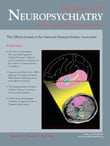Schizophrenia-Like Psychosis Following Right Putaminal Infarction
SIR : Schizophrenic symptoms are sometimes caused by physical disorders affecting brain function. Neuroimaging findings in these cases give useful information for understanding the neuropsychiatric background of schizophrenic symptoms, especially in early stage neurodegenerative disease and focal cerebrovascular disorders. Here, we report a case of schizophrenia-like psychosis following right putaminal infarction.
Case Report
The patient was a 40-year-old right-handed Japanese high-school graduate without a history of psychotic illness. Following her father’s death, she developed subacute auditory hallucinations and persecutional delusions (for example, she thought someone was intruding into and wiretapping her house, or believed that her child had been kidnapped). A few days later, she became excitable and tried to strangle her husband, after which she was restrained by her family and admitted to our hospital. On admission, she was alert, and physical and neurological examinations revealed no abnormalities. Laboratory tests were normal. A magnetic resonance imaging (MRI) scan revealed a subacute right putaminal infarction, which was partially extended to the right caudate and insula. The infarction was treated conservatively. Administration of risperidone (5mg/day) was initiated and the psychotic symptoms gradually disappeared. Two months later, the psychotic symptoms had completely disappeared and she was discharged. The regimen of risperidone was tapered off over the following 6 months and no relapse was observed.
Comment
Cummings 1 noted that subcortical structures (striatum [caudate and putamen], globus pallidus, and thalamus) and the prefrontal cortex form three circuits (dorsolateral prefrontal, lateral orbital, and anterior cingulate circuits) and these circuits mediate many aspects of human behavior. On the other hand, recent neuroimaging studies in schizophrenia have demonstrated morphological and functional abnormalities of the frontal-subcortical circuits, although these results remain ambiguous. 2 , 3
In our patient, a right putaminal infarction, which affects the dorsolateral prefrontal and lateral orbital circuits, caused schizophrenia-like hallucinations and delusions. In contrast, a case of schizophrenia in which hallucinations and delusions disappeared following left putaminal hemorrhage was previously reported. 4 In this previous case, it could be speculated that excessive left frontal-subcortical function was associated with schizophrenic symptoms, and that correction of the excess function by left putaminal hemorrhage extinguished the symptoms. Collectively, these findings suggest that left and right frontal-subcortical functional asymmetry (i.e., relative right hemispheric hypofunction or relative left hemispheric hyperfunction) may play a critical role in the appearance of schizophrenic symptoms, especially for hallucinations and delusions.
1. Cummings JL: Frontal-subcortical circuits and human behavior. Arch Neurol 1993; 50:873–880Google Scholar
2. Suzuki M, Zhou SY, Takahashi T, et al: Differential contributions of prefrontal and temporolimbic pathology to mechanisms of psychosis. Brain 2005; 128:2109–2122Google Scholar
3. Andreasen NC, Paradiso S, O’Leary DS: “Cognitive dysmetria” as an integrative theory of schizophrenia: a dysfunction in cortical-subcortical-cerebellar circuitry? Schizophr Bull 1998; 24:203–218Google Scholar
4. Nagara T, Ohara H, Yano K, et al: Disappearance of hallucinations and delusions following left putaminal hemorrhage in a case of schizophrenia. Seishin Shinkeigaku Zasshi 1996; 98:498 (In Japanese)Google Scholar



